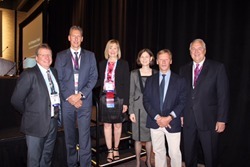by
Thomas Dworetzky, Contributing Reporter | June 30, 2017
Supplies of molybdenum-99 (Mo-99) are secure and reliable, according to an expert panel at the June meeting in Denver of the Society of Nuclear Medicine and Molecular Imaging (SNMMI).
The panel, moderated by SNMMI President Sally Schwarz, professor of radiology at the Mallinckrodt Institute of Radiology at the Washington University School of Medicine in St. Louis, included Jayne Senior, general manager of ANSTO Nuclear Medicine; Frank de Lange, vice president, Manufacturing, Petten and managing director of Curium; Jean-Michel Vanderhofstadt, CEO of the Institute for Radio Elements (IRE); and Piet Louw, executive manager of NTP Radioisotopes.
“It’s clear that the world’s Mo-99 producers have collaboratively used innovation, technology and careful planning to increase capacity and safeguard supplies of this critical medical isotope,” said Schwarz.



Ad Statistics
Times Displayed: 2890
Times Visited: 28 Fast-moving cardiac structures have a big impact on imaging. Fujifilm’s SCENARIA View premium performance CT brings solutions to address motion in Coronary CTA while delivering unique dose saving and workflow increasing benefits.
Some of the steps taken to secure the supply of Mo-99 have included:
1. Increased capacity by present Mo-99 producers through “significant” investments and improvements.This includes steps taken to boost supply to cover planned and unplanned demand spikes, and to replace lost capacity anticipated from the closing of Mo-99 production at the NRU and OSIRIS research reactors.
2. Maintenance and investments by major producers for “extra target irradiation positions with their reactor partners (known as Outage Reserve Capacity) to continue to provide supply during an unexpected shutdown.” Producers pay for target irradiation space – used or not.
3. Global cooperation. The Association of Imaging Producers and Equipment Suppliers (AIPES) is cooperating around the world to manage an international scheduling of Mo-99-producing reactors, to ensure “adequate target irradiation capacity and minimize supply risks.” The group includes major international Mo-99 producers who meet during the year to make sure that the supply of Mo-99 and hence Tc-99M is secure going forward.
“With these safeguards and investments in Mo-99 production, we look forward to offering the nuclear medicine community peace of mind and stability for the future,” Schwarz advised during the panel.
The Mo-99 challenge has been ongoing for a number of years.
For example, in May
reports surfaced that SHINE Medical Technologies had hit a money-raising snag – and is turning to building a prototype of its full-scale radioisotope-producing facility in Janesville, Wisconsin.
This could stall by three-to-six months the goal of commercial Mo-99 production at SHINE's to-be-built $100 million, 57,000 square-foot main plant in Janesville, Wisconsin, until 2020 – most recently scheduled for mid-2019.

